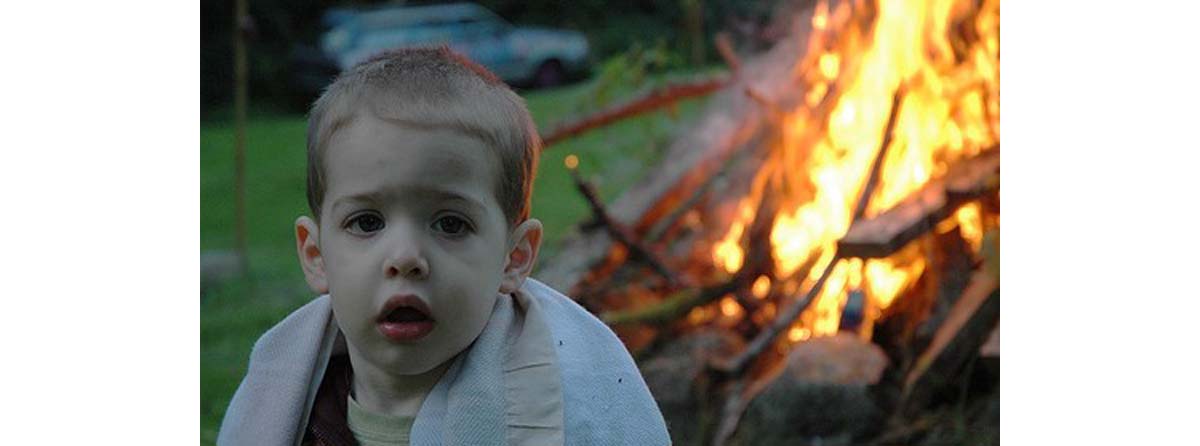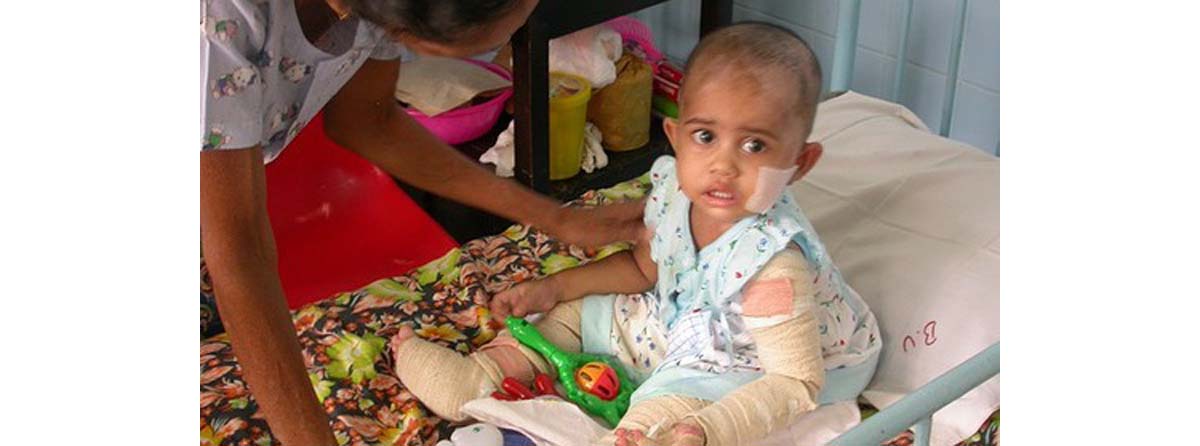Accidental burns are a safety threat for children of all ages. Hot water scalds from a very hot faucet and hot beverage spills are two of the most common sources of burn injuries in children. Burns in general are at the top of the childhood accidents list. Small children and babies are at an increased risk of burns because of their high curiosity level, their small size, and the increased sensitivity of their skin.

The majority of small, minor burns can be effectively treated at home without the need for medical attention. If a child experiences a more serious burn, howver, prompt medical treatment is required. The most effective "treatment" for burns in children is and will always be prevention. There are simple steps parents and caregivers can take that will help to prevent both minor and more serious burns in little ones.
Common Causes of Burns in Children
In order for parents and caregivers to effectively prevent burns in children, it is important for them to be aware of the leading causes of burns in the home or child care environment. The leading cause of burns in children is due to scalds that result from hot fluids, steam or hot foods.
Small children are susceptible to scalds from a running faucet that is too hot, bath water that is too hot, spilled cups of coffee, tea or soup, coming into contact with hot foods and accidental spillage of hot cooking liquids such as boiled water and cooking oils.
Coming into contact with hot objects is another leading cause of burns in children. An open oven door, hot object lying on top of the stove, heat from the fireplace, a heated iron or curling iron are all common household objects that can result in serious burns.
Chemical burns are also common in children. Chemical burns can result from exposure to chemicals such as cleaning products, bleach, drain cleaner or yard chemicals but can also occur as a result of swallowing things such as watch batteries.
Electrical burns can develop as a result of children sticking their fingers into electrical outlets or even from biting on electrical cords that are plugged in, which is more common than you might think.
Being aware of these sources of burns can help you in various ways:
- Be extra watchful around hot stoves, irons, and other household appliances that become dangerously hot.
- Wait until tea, hot chocolate, or meals cool down sufficiently before serving them to children.
- Childproof the environment.
- Start teaching children about the risks of burns.
Types of Burns
The way a burn is categorized depends on the severity of the burn and the amount of skin damage that occurs. Burns are categorized by degrees according to the severity of the burn. First degree is the least severe, followed by second degree, with third degree being the most severe.
All of the different burn injuries listed above can result in burns of all degrees. The cause of the burn and the severity of it will both determine what type of treatment should be utilized.
First degree burns only affect the top layer of the skin. Theses burns cause pain, redness and occasionally some minor swelling can occur. The average healing time for first degree burns is 3-6 days. Medical attention is not usually required.
With second degree burns, the layers of skin below the top layer are also affected. These burns cause extreme pain, redness, blisters that can break open and ooze. It can take as long as 3 weeks or more for these burns to heal and medical attention is advised.
Third degree burns are severe burns that affect every layer of skin as well as the tissue underneath. The skin surface has a waxy appearance that is looks dry, leathery, white or brown and badly charred. There may or may not be pain with this type of burn, as the entire area may have nerve damage that results in numbness. These burns must be treated in specialist centers, with care being an ongoing and difficult process.
Treatment and Home Care for Burns in Children
All severe burns should be treated by a medical professional. If you suspect the child may have a second or third degree burn, seek immediate medical attention. Small first degree burns can often be treated at home, as long as they do not cover a large area of the body. If the affect the face, scalp, hands or genitals, immediate medical attention should be sought. All burns that occur as a result of fire, chemicals, electrical wires or electrical sockets should be evaluated by a medical professional.
To treat a first degree burn at home, the child must immediately be removed from the source of heat. Strip off all clothing in the affected area. Immediately run cool water or any cool liquid over the burned skin or apply a cold compress to the burn. Do this for 3-5 minutes. Never apply ice, wet compresses or very cold water, as this can result in the body temperature dropping and can increase skin damage. Avoid grease, powder, butter or similar remedies that can worsen the burn and possibly cause infection. Aloe Vera gel is a safe remedy that can be applied several times each day. Children’s pain killers can be given for pain as needed. Make sure the affected area remains clean. Cover it with a gauze pad or bandage for the first 24 hours, then remove and allow the burn to heal.
How To Protect Children From Injuries That Result In Burns
General Tips
Although it isn’t always possible to protect children from injuries that result in burns, there are certain precautions that can be put in place in order to decrease the risk of burns occurring. Simple steps like keeping all flammables out of children’s reach, utilizing outlet covers for all electrical outlets, discarding old, damaged or frayed electrical cords, and installing a smoke alarm on each level in the home, will dramatically reduce the chances of an injury that results in a burn.

Instruct Children
It is essential to warn children of the risks of burns and to explain safety procedures accordingly. Teens and older children should be instructed on the proper use of irons, hair dryers, curling irons and flat irons. The same should be done for toasters, blenders and other kitchen appliances.
Humidifiers
Many parents choose to use a humidifier in their children’s bedroom, especially during a cold, flu, sinus infection or respiratory illness. When doing so, make sure that a cool-mist humidifier is used to prevent steams burns that can occur when using a warm-mist or hot-steam humidifier.
Kitchen Tips
A good portion of burns that occur do so in the kitchen.
This will prevent little ones from reaching up and grabbing the hot handle. Whenever possible, try to block all access to the stove, making it difficult for children to come in contact with hot items. If you have a small child that uses a walker to cruise around the home, use a gate to block off access to the kitchen. A child in a walker can bang into tables, knocking over or spilling hot food items.
Precautions for Parents
Never drink hot beverages while holding a baby or small child or while a child is sitting on your lap.
If children are running around, refrain from carrying a hot plate of food or got beverage near them. Make sure the children are not in the kitchen when transporting hot foods from the oven to the table. Don’t ever cook while holding a baby or child in your arms.
When warming up a bottle for a baby, avoid doing so in the microwave oven, as this can cause the liquid to heat in an uneven manner. When this occurs, the breast milk or formula can develop hot pockets that can burn the baby’s mouth or lips.
Bathroom Precautions
The hot water heater should be set on the low-medium setting to prevent scalding. It does not take long for a child to be scalded by faucet water that is too hot. If the water temperature is above 140 degrees, a child can be scalded after just 5 seconds of contact with the water. Parents who live in an apartment without access to the water heater thermometer can purchase an inexpensive anti-scalding device that can be easily installed.
When filling the tub, turn on the cold water first. When turning the water off, be sure to turn off the hot water first. Before placing your child in the bathtub, be sure to first test the temperature of the water. Using your elbow to do so is more effective than using your hand, as it allows for a more accurate temperature estimate. When placing your child in the tub, face him away from the faucet so he does not turn the water on.
- Photo courtesy of Andy Pixel by Flickr : www.flickr.com/photos/smull/57796108/
- Photo courtesy of ReSurge International by Flickr : www.flickr.com/photos/interplast/1851728706/


Your thoughts on this